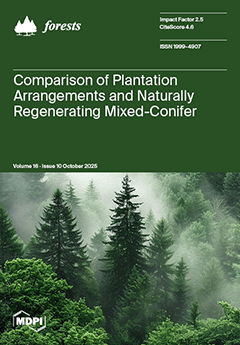Soil microorganisms are important decomposers in soil, and they play important roles in litter degradation, nutrient cycle and balance, soil physicochemical property improvement, and soil fertility maintenance. To understand the influence of
Eucalyptus plantations on the growth, reproduction, and activity of soil microorganisms in severely degraded land, the Leizhou Peninsula in tropical China was selected as the research area. The vegetation restoration types of
Eucalyptus urophylla ×
grandis planted in its severely degraded red soil areas (ES:
Eucalyptus–shrub, EG:
Eucalyptus–grass, and ED:
Eucalyptus–
Dicranopteris pedata (Houtt.) Nakaike) were studied, and the nearby natural vegetation types (S: shrub, G: grass, and D:
Dicranopteris pedata) served as control groups. The microbial characteristics of different vegetation restoration types were compared, and the influence of
Eucalyptus plantations on the growth, reproduction, and activity of soil microorganisms in severely degraded red soil areas was discussed by setting up sample plots for investigation, sample determination, and statistical analysis. The structure of soil microorganisms differed significantly between
Eucalyptus vegetation restoration (ER) and natural vegetation restoration without
Eucalyptus (NER). Key organic decomposers, including bacterial genera such as
Candidatus Solibacter (ER: 1.2 ± 0.4% vs. NER: 0.9 ± 0.1%),
Candidatus Koribacter (ER: 1.0 ± 0.4% vs. NER: 0.7 ± 0.1%), and
Edaphobacter (ER: 0.9 ± 0.1% vs. NER: 0.4 ± 0.1%), as well as fungal genera such as
Rhizophagus (ER: 0.1 ± 0.0% vs. NER: 0.0 ± 0.0%),
Paxillus (ER: 0.1 ± 0.0% vs. NER: 0.0 ± 0.0%), and
Pisolithus (ER: 0.1 ± 0.0% vs. NER: 0.0 ± 0.0%), exhibited a significantly higher relative richness and a broader distribution in ER compared to NER (
p < 0.05). Soil microbial biomass carbon, nitrogen and phosphorus (MBC, MBN, MBP), community structure (keystone taxa and symbiosis network complexity), and functional genes (for growth, reproduction, and decomposition) in ER, especially in ES, were significantly higher than in NER. This study illustrated that
Eucalyptus plantations, especially ES types, can promote the growth and reproduction of soil organic decomposers, improve microbial metabolic and biological activities, and increase functional diversity and interactions among microorganisms, thus accelerating the cycle of soil carbon, nitrogen, and phosphorus nutrients, improving soil quality and fertility, and accelerating the recovery of degraded soil fertility. In areas with serious soil degradation and where natural vegetation restoration is difficult, planting
Eucalyptus, especially while guiding the understory vegetation to develop into the shrub vegetation type, is an effective vegetation restoration model.
Full article





